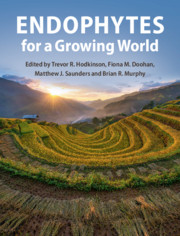Book contents
- Endophytes for a Growing World
- Endophytes for a Growing World
- Copyright page
- Contents
- Contributors
- Preface
- Part I Introduction
- Part II Role of Endophytes in Growth and Biotic and Abiotic Stress Resistance
- Part III Diversity and Community Ecology of Endophytes
- 8 Microbispora Dominate Diversity of Endophytic Actinobacteria from Australian Rice Plants
- 9 Isolation, Diversity and Potential Use of Endophytes in the Biomass and Bioenergy Crop Miscanthus
- 10 Life Within the Leaf: Ecology and Applications of Foliar Bacterial Endophytes
- 11 Meta-Omics Approach to Unravel the Endophytic Bacterial Communities of Brassica napus and Other Agronomically Important Crops in Response to Agricultural Practices
- 12 The Influence of Endophytes on Cork Oak Forests Under a Changing Climate
- Part IV Endophytes for Novel Biomolecules and In Vitro Methods
- Part V Application and Commercialisation of Endophytes in Crop Production
- Index
- References
10 - Life Within the Leaf: Ecology and Applications of Foliar Bacterial Endophytes
from Part III - Diversity and Community Ecology of Endophytes
Published online by Cambridge University Press: 01 April 2019
- Endophytes for a Growing World
- Endophytes for a Growing World
- Copyright page
- Contents
- Contributors
- Preface
- Part I Introduction
- Part II Role of Endophytes in Growth and Biotic and Abiotic Stress Resistance
- Part III Diversity and Community Ecology of Endophytes
- 8 Microbispora Dominate Diversity of Endophytic Actinobacteria from Australian Rice Plants
- 9 Isolation, Diversity and Potential Use of Endophytes in the Biomass and Bioenergy Crop Miscanthus
- 10 Life Within the Leaf: Ecology and Applications of Foliar Bacterial Endophytes
- 11 Meta-Omics Approach to Unravel the Endophytic Bacterial Communities of Brassica napus and Other Agronomically Important Crops in Response to Agricultural Practices
- 12 The Influence of Endophytes on Cork Oak Forests Under a Changing Climate
- Part IV Endophytes for Novel Biomolecules and In Vitro Methods
- Part V Application and Commercialisation of Endophytes in Crop Production
- Index
- References
Summary
Endophytic bacteria have evolved to survive within plant leaf tissue while potentially providing benefits to their host. This relationship makes them uniquely applicable as agricultural biocontrol agents, sources of natural chemicals/products, plant growth promoters and mediators of phytoremediation. Foliar bacterial endophytes colonise leaf tissue through vertical transmission (i.e. through seed or pollen) or horizontal transmission (i.e. colonisation through environmental contact of the roots, wounds, stomatal infiltration, insect vectors, and airborne dispersal). The taxonomic diversity of foliar endophytes spans at least seven bacterial classes and they occupy hosts from all taxanomic groups of plants tested. Bacterial leaf endophytes can promote plant health by stimulating and producing plant hormones for growth and preventing pathogenic infection. Plant-pathogenic bacteria can be found residing within leaf tissue asymptomatically raising questions about the relationship between endophyte–host specificity. Similarly, human pathogenic enterobacteria not usually associated with plants have been found to persist as endophytes. Bioactive secondary metabolites produced by these endophytes have been broadly applicable as antifungals, antibiotics, and other compounds used for agricultural and human health. Endophyte research carries unique challenges that require novel and adaptive strategies for separation of plant and bacterial DNA. This chapter will focus on bacteria isolated from within plant leaf tissue with a focus on transmission, diversity, function and challenges associated bacterial leaf endophyte research.
- Type
- Chapter
- Information
- Endophytes for a Growing World , pp. 208 - 231Publisher: Cambridge University PressPrint publication year: 2019
References
- 4
- Cited by

